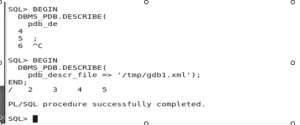CONVERTING NON-CONTAINER DATABASE TO CONTAINER DATABASE
In this tutorial, we are going to learn about how to convert a non-container database to a container database.
Before that, we need to install both the database i.e non container database and non – container database in dbca or manually.
Here i have a mentioned below details of noncontainer database and container database name:
Non-Container database name – gdb1
Container database – ndb1
Step1:
At first, we want to ensure both the database is running or not using
$ps – ef |grep pmon

Step 2:
Open the Non-Container database as read-only mode.
SQL> shut immediate
Database closed.
Database dismounted.
ORACLE instance shut down.
SQL> startup mount exclusive
ORACLE instance started.
Total System Global Area 1862270976 bytes
Fixed Size 8621952 bytes
Variable Size 553648256 bytes
Database Buffers 1291845632 bytes
Redo Buffers 8155136 bytes
Database mounted.
SQL> alter database open read-only;
Database altered.
Step3: Create the XML file needed for cdb conversion using the DBMS_PDB.DESCRIBE procedure.

The above pl/SQL procedure will create the XML file in which you mention on that.

Step 3:Shutdown the NON-CDB database.
SQL> shutdown immediate
Database closed.
Database dismounted.
ORACLE instance shut down.
SQL>
Step 4: Open the cdb database.
export ORACLE_SID=ndb1
[oracle@gg1 dbs]$ sqlplus / as sysdba
SQL*Plus: Release 12.2.0.1.0 Production on Sat Jan 23 17:18:20 2021
Copyright (c) 1982, 2016, Oracle. All rights reserved.
Connected to an idle instance.
SQL> startup
ORACLE instance started.
Total System Global Area 1862270976 bytes
Fixed Size 8794024 bytes
Variable Size 553648216 bytes
Database Buffers 1291845632 bytes
Redo Buffers 7983104 bytes
Database mounted.
Database opened.
SQL> select name,open_mode,cdb from v$database;
NAME OPEN_MODE CDB
——— ——————– —
NDB1 READ WRITE YES
Step 5: Check the compatibility of PDB on ( ORA_CDB)
SET SERVEROUTPUT ON;
DECLARE
Compatible CONSTANT VARCHAR2(3) := CASE DBMS_PDB.CHECK_PLUG_COMPATIBILITY(pdb_descr_file => ‘/tmp/gdb1.xml’)
WHEN TRUE THEN ‘YES’
ELSE ‘NO’
END;
BEGIN
DBMS_OUTPUT.PUT_LINE(compatible);
END;
/
YES
PL/SQL procedure successfully completed.
Step 6: Check the violations :

Step 7: Create a pluggable database in container DB
SQL> create pluggable database gdb1 using ‘/tmp/gdb1.xml’ NOCOPY tempfile reuse;
Pluggable database created.
Step 8: Switch the Newly created pdb .
SQL> ALTER SESSION SET CONTAINER=GDB1;
Session altered.
Step 9: Run the noncdb_to_pdb.sql script
SQL> @$ORACLE_HOME/rdbms/admin/noncdb_to_pdb.sql
SQL> SET SERVEROUTPUT ON
SQL> SET FEEDBACK 1
SQL> SET NUMWIDTH 10
SQL> SET LINESIZE 80
SQL> SET TRIMSPOOL ON
SQL> SET TAB OFF
SQL> SET PAGESIZE 100
SQL> SET VERIFY OFF
SQL>
SQL> — save settings
SQL> STORE SET ncdb2pdb.settings.sql REPLACE
Wrote file ncdb2pdb.settings.sql
SQL>
SQL> SET TIME ON
16:12:03 SQL> SET TIMING ON
16:12:03 SQL>
16:12:03 SQL> WHENEVER SQLERROR EXIT;
16:12:03 SQL>
16:12:03 SQL> DOC
Step 10: Open the PDB
SQL> alter Pluggable database gdb1 open;
Pluggable database altered.
SQL> SELECT name, open_mode FROM v$pdbs;
NAME OPEN_MODE
——————– ———-
GDB1 READ WRITE
